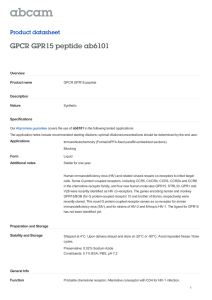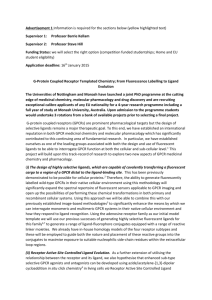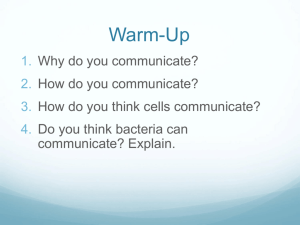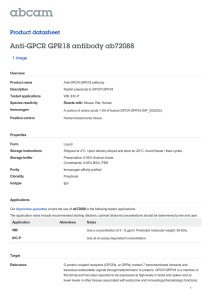The IUPHAR database of G protein-coupled receptors and ion channels -db.org
advertisement
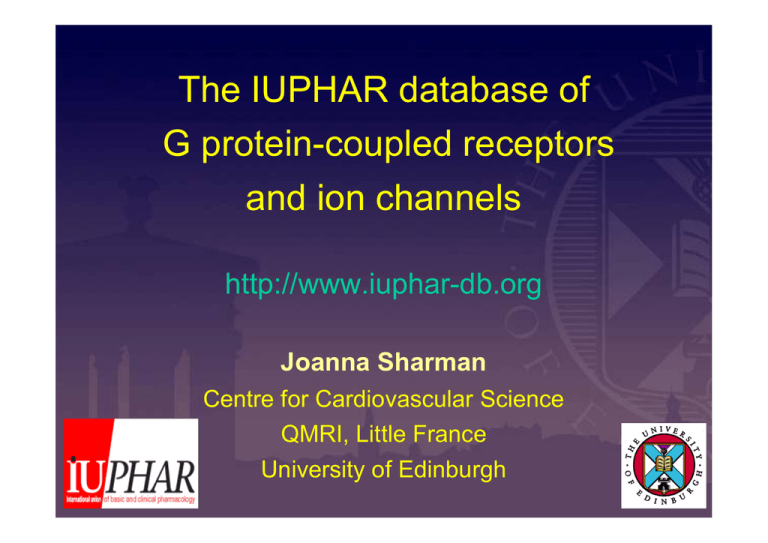
The IUPHAR database of G protein-coupled receptors and ion channels http://www.iuphar-db.org Joanna Sharman Centre for Cardiovascular Science QMRI, Little France University of Edinburgh Introduction to IUPHAR-DB The International Union of Basic and Clinical Pharmacology Committee on Receptor Nomenclature and Drug Classification (NC-IUPHAR) • Founded 1987 • Classifying the major receptor and ion channel systems • Working with HGNC to facilitate the classification of new sequences discovered from the Human Genome Project • Setting up a website with access to data on all known receptor systems, freely available to all scientists, anywhere in the world. IUPHAR Database scope • About 10% of the ~30,000 genes in the human genome are estimated to express proteins able to bind drug-like molecules - “the druggable genome”. • G protein-coupled receptors (GPCRs) (~400) • Voltage-gated ion channels (~150) • Ligand-gated ion channels (~80) • Nuclear hormone receptors (48) • Transporters (~95) • Receptor tyrosine kinases (~60) • Peer-reviewed pharmacological, chemical, genomic, functional and anatomical information Quick tour of IUPHAR-DB http://www.iuphar-db.org/GPCR/ReceptorFamiliesForward A receptor family page An individual receptor data page Radioligand Radioligand Selectivity Selectivity Endogenous Endogenous PubChem PubChem Link Link Tables of ligand affinity data Other useful IUPHAR-DB.org features •Receptor and ion channel lists and downloadable spreadsheets •Reports of latest receptor-ligand pairings •Hot topics page with recent publications of interest •Receive news of updates via RSS feed or email subscription Overview of biological data complexities that need to be represented Increasing complexity in intercellular signalling mechanisms • Alternative splicing and RNA editing • GPCR heterodimerisation • GPCR accessory proteins (e.g. RAMPs) GPCR subtypes can be generated in several ways R1a R1a R1b R1a R1a R1b AP R1a Source: Debbie Hay, University of Auckland Increasing complexity in intercellular signalling mechanisms • Alternative splicing and RNA editing • GPCR heterodimerisation • GPCR accessory proteins (e.g. RAMPs) • Ion channels can exist as tissue-and cell-specific heteromultimeric complexes with distinct pharmacological and biophysical properties Current and future work Current work - Improvement of search facility Current work - Ligand-centered pages Current work – Depositing data in PubChem Current work – Redesign database to merge GPCRs and ion channels Curation process • NC-IUPHAR coordinates a network of >60 expert subcommittees • How can we make the process more efficient? • Future: enable contributors to submit data directly e.g. using Wiki-style pages? NC-IUPHAR IUPHAR Database Edinburgh Team Tony Harmar (Chair) Joanna Sharman (Database Developer) Valerie Hale (Curator) Alumni Rebecca Hills (Elsevier) Martin Jones (University of Edinburgh) Stuart Greenhill (NeuroSolutions Ltd) Ed Rosser (Lhasa Ltd) Database group, School of Informatics Peter Buneman Heiko Mueller Loreto Bravo Bioinformatics Team, QMRI Donald Dunbar Ann Hedley Jon Manning Michael Spedding (Servier, France) (Chair) Tony Harmar (Edinburgh, UK) (Vice-chair) Eliot Ohlstein (Venuvics, USA) (Vice-chair) Anthony Davenport (Cambridge, UK) (Vice-chair) Tom Bonner (NIH, USA) Vincent Laudet (Lyon, France) William Catterall (Seattle, USA) Graeme Milligan (Glasgow, UK) Philippe Delagrange (Servier, France) Rick Neubig (Ann Arbor, USA) Sir Colin Dollery (GlaxoSmithKline, UK) John Peters (Dundee, UK) Steven Foord (GlaxoSmithKline, UK) Jean-Philippe Pin (Montpellier, France) Pierre Germain (Strasbourg, France) David Searls (GlaxoSmithKline, USA) Sue Duckles (Irvine, USA), IUPHAR president Sam Enna, (Kansas, USA), IUPHAR Secretary General Urs Ruegg (Geneva, Switzerland), IUPHAR treasurer Matt Wright (London, UK), HUGO representative
